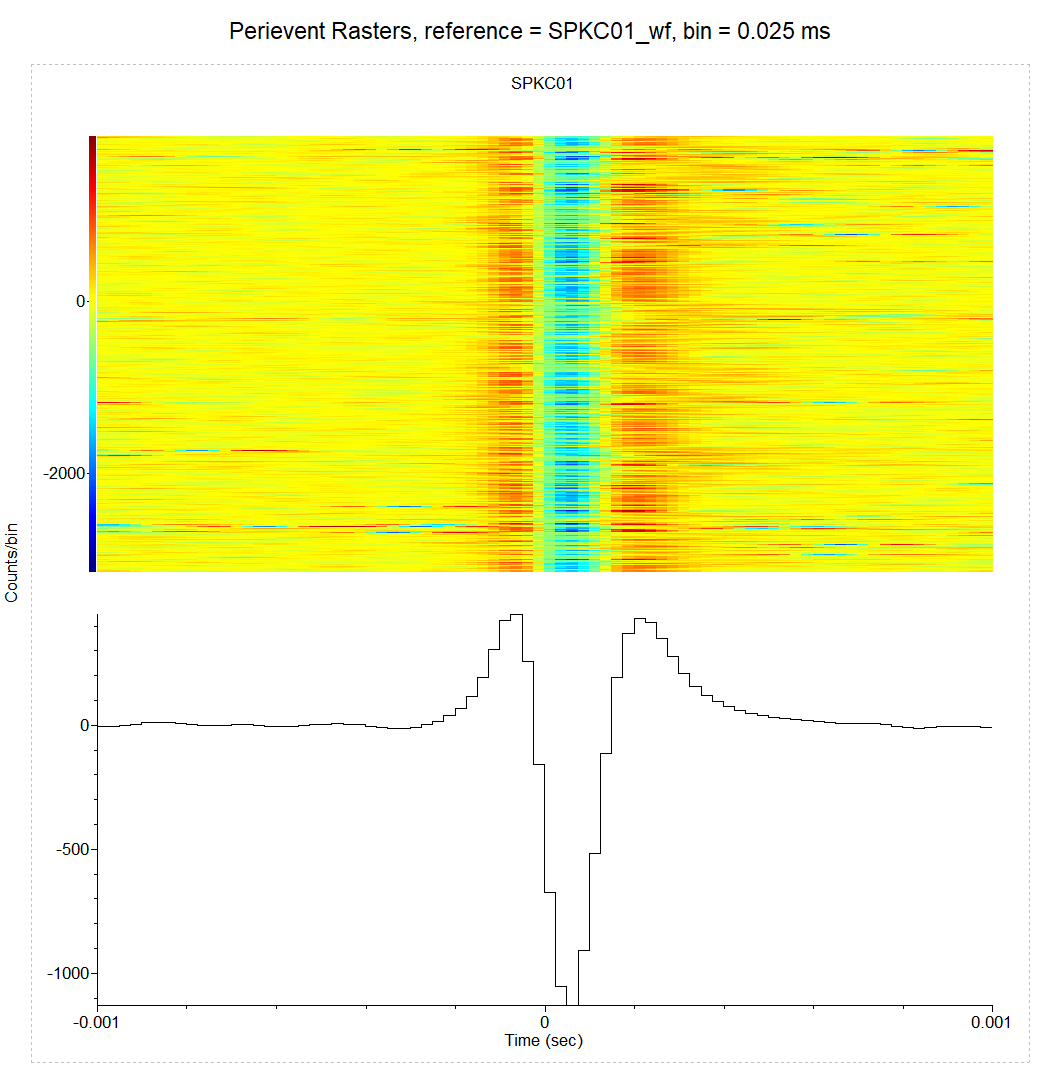Perievent Rasters
This analysis shows the timestamps of the selected variable relative to the timestamps of the reference variable.
Parameters
Parameter |
Description |
|---|---|
Reference Type |
Specifies if the analysis will use a single or multiple reference events. |
Reference |
Specifies a reference neuron or event (or a group of reference neurons or events). |
XMin |
Time axis minimum in seconds. |
XMax |
Time axis maximum in seconds |
Markers |
An option to display additional events (as markers - triangles, squares, etc.) in the perievent raster. |
Background Intervals |
An option to draw intervals in the raster background. |
Trial Order |
This option allows you to specify how the raster lines are drawn. The raster lines (corresponding to reference events) can be drawn in the order of reference events (with the first event on top, the last at the bottom of the perievent raster), or in the reverse order (the first event at the bottom of the raster display, the last event at the top). This option is ignored if Sort trials parameter is not None. |
Sort trials |
An option to sort raster lines. By default, the raster lines (corresponding to reference events) are drawn in the order specified by the Trial Order parameter. This option allows you to display reference events in a different order. For example, in behavioral experiments, you can sort the trials according to the latency of the response. |
Sort event |
Specifies how to identify the timestamps (in Sort ref. variable) that will be used in sorting. |
Sort ref. |
Specifies event variable that will be used to sort trials. |
Histogram |
An option to draw a histogram. |
Bin |
Histogram bin size in seconds. |
Normalization |
Histogram units (Counts/Bin, Probability or Spikes/Second). See Algorithm below. |
No Selfcount |
An option not to count reference events if the target event is the same as the reference event. Prevents a histogram to have a huge peak at zero when calculating PSTH versus itself. |
Select Data |
If Select Data is From Time Range, only the data from the specified (by Select Data From and Select Data To parameters) time range will be used in analysis. See also Data Selection Options. |
Select Data From |
Start of the time range in seconds. |
Select Data To |
End of the time range in seconds. |
Int. filter type |
Specifies if the analysis will use a single or multiple interval filters. |
Interval filter |
Specifies the interval filter(s) that will be used to preselect data before analysis. See also Data Selection Options. |
Create filter on-the-fly |
Specifies if a temporary interval filter needs to be created (and used to preselect data). |
Create filter around |
Specifies an event that will be used to create a temporary filter. |
Start offset |
Offset (in seconds, relative to the event specified in Create filter around parameter) for the start of interval for the temporary filter. |
End offset |
Offset (in seconds, relative to the event specified in Create filter around parameter) for the end of interval for the temporary filter. |
Fix overlaps |
An option to automatically merge the overlapping intervals in the temporary filter. |
Smooth histogram |
An option to smooth the histogram after the calculation. See Post-Processing Options for details. |
Smooth Filter Width |
The width of the smooth filter. See Post-Processing Options for details. |
Summary of Numerical Results
The following information is available in the Summary of Numerical Results
Column |
Description |
|---|---|
Variable |
Variable name. |
Reference |
Reference variable name. |
NumRefEvents |
The number of reference events used in calculation. |
YMin |
Histogram minimum. |
YMax |
Histogram maximum. |
Spikes |
The number of spikes used in calculation. |
Filter Length |
The length of all the intervals of the interval filter (if a filter was used) or the length or the recording session (in seconds) |
Mean Freq. |
Mean firing rate (Spikes/Filter_Length). |
Mean Hist. |
The mean of the histogram bin values. |
St. Dev. Hist. |
The standard deviation of the histogram bin values. |
St. Err. Mean. Hist. |
The standard error of mean of the histogram bin values. |
Algorithm
Spike Trains
For the perievent histogram calculation,
Let ref[i] be the array of timestamps of the reference event, sortref[i] be the array of timestamps of the sort event.
If Sort Trials is selected, the following algorithm is used:
for each timestamp
ref[k], NeuroExplorer finds the smallestsortref[i], such that
sortref[i] > ref[k]
the distance between two events is calculated:
dist[k] = sortref[i] - ref[k]
the trials
ref[k]are sorted array sorted in ascending or descending order ofdist[k].
Continuous Variables
Continuous variables can also be used in this analysis. However, you may prefer to use PeriEvent Rasters for Continuous Variables analysis.
For each ref[k], NeuroExplorer calculates a series of bins. The first bin is:
[ref[k]+XMin, ref[k]+XMin+Bin]
the second bin is [ref[k]+XMin+Bin, ref[k]+XMin+Bin+Bin], etc.
Then, the average value of a continuous variable is calculated within each of the bins and this average value is displayed using the color scale. If bin does not contain any timestamps of the continuous variable, the previous value of the continuous variable is used.
